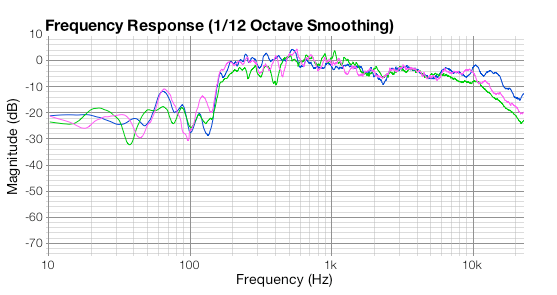Look Ma .... No Crossover
75.179.179.173 |
||
| Posted on January 25, 2010 at 11:32:40 | ||
|
Posts: 5430
Joined: July 6, 2002 |
 Using a Marchand XM44 (LR4 topology) to triamp my Tympani/Neo 8 Mod speakers, I have been complaining about an excess of op amps in the midrange bandpass. In order to address this, I was applying various low order passive line level crossovers. The best sounding was a bessel 2nd order bass LP with a first order mid bandpass and treble HP. This - however, required setting up the midrange/treble panels in front of the bass panels in order to match phase. This restriction damaged spatial resolution. With 2nd order bessel as well - on all drivers, there had been no crossover region gain to speak of when keeping the panels in their equidistant arc - where imaging seems to be best. A few weeks ago I looked at one of BG's in wall pro speakers using a line array of Neo8 such as my own, and noticed their acoustic crossover. When I was reading about the Prometheus II speakers some time later I realized that the power handing of the Neo8 and its high sensitivity (96 db or so for a 6 part line array) may actually allow running it full range, so that I need only fill out the extreme ends with the bass panels and tweeter. And there was this recent measurement of a Neo8 line array (see Image URL) with better instrumentation than I have. So I unplugged the midrange from the Marchand crossover and tapped the preamp. I first listened to the midrange driver alone (XM44 turned off) with SS, and played it fairly loud (greater than 100 db spl peak at my listening seat). With Bach/Mariner piano concertos on CD, I noticed that the low level harpsicord continuo that was previously totally lacking in reverberant characteristics and had totally no texture at all had finally come to sound like a harpsicord. I had always attributed this reproduction flaw to it being low level digital, since low level harpsicord came out clear in LP playback. Well, it is clearer now... In short, the Neo8 line array was doing very well from a bit below middle C up to the high harmonics. Significantly better even than with a first order crossover. So much so, that you could hear the volume adjustments on the DG Tchaikovsky/Richter LP, and Richter's breathing had its own image on the stage. This is something I had never heard before - DG's golden era recordings never revealed the engineer's slight of hand, nor did the solo artist's breathing ever come through on their recordings. I repeated the listening test with the Marchand turned on with the crossover points unchanged for the bass and tweeter at -6 db points of 300 and 5000HZ (-3 db at 240 & 6000). There was no loss of clarity nor of detail, and their integration was good though not perfect. Definitely viable as is. Driving the midrange via the Marchand, I was struck by how much more detail the brighter sounding Schultz/Nuforce 8.5 had managed to get while the Dynaco MkIII's despite being upgraded with true premium parts and operating in Triode (KT90 EH) could not do the same. Playing both without the midrange crossover, there was no great shakes difference between the SS class D amp and the Dynaco Triodes in their presentation of detail and the tonal balance became much closer. The "detail" was an artifact of the Marchand's op amp brightness. It was emphasized on the single ended Nuforce, and partially canceled out on the push-pull Dynaco - or at least so I am guessing. The message here is to all ye tri-ampers of Tympanis, MG3.x and MG20s, give yourself a boost with the Neo8 line source. It has less distortion and much much higher sensitivity than the original maggie midranges and so can be powered by low watt SETs and middle power triodes of the 40 watt range. Power handling allows it to be run sans crossover - thereby removing phase issues from the bulk of the musical output. A line of 6 to 8 drivers per side will set you back under $1K and is easy to assemble and wire. Now I need to work on determining new crossover points and slopes to perfectly integrate the bass and ribbon tweeter.
|
|

